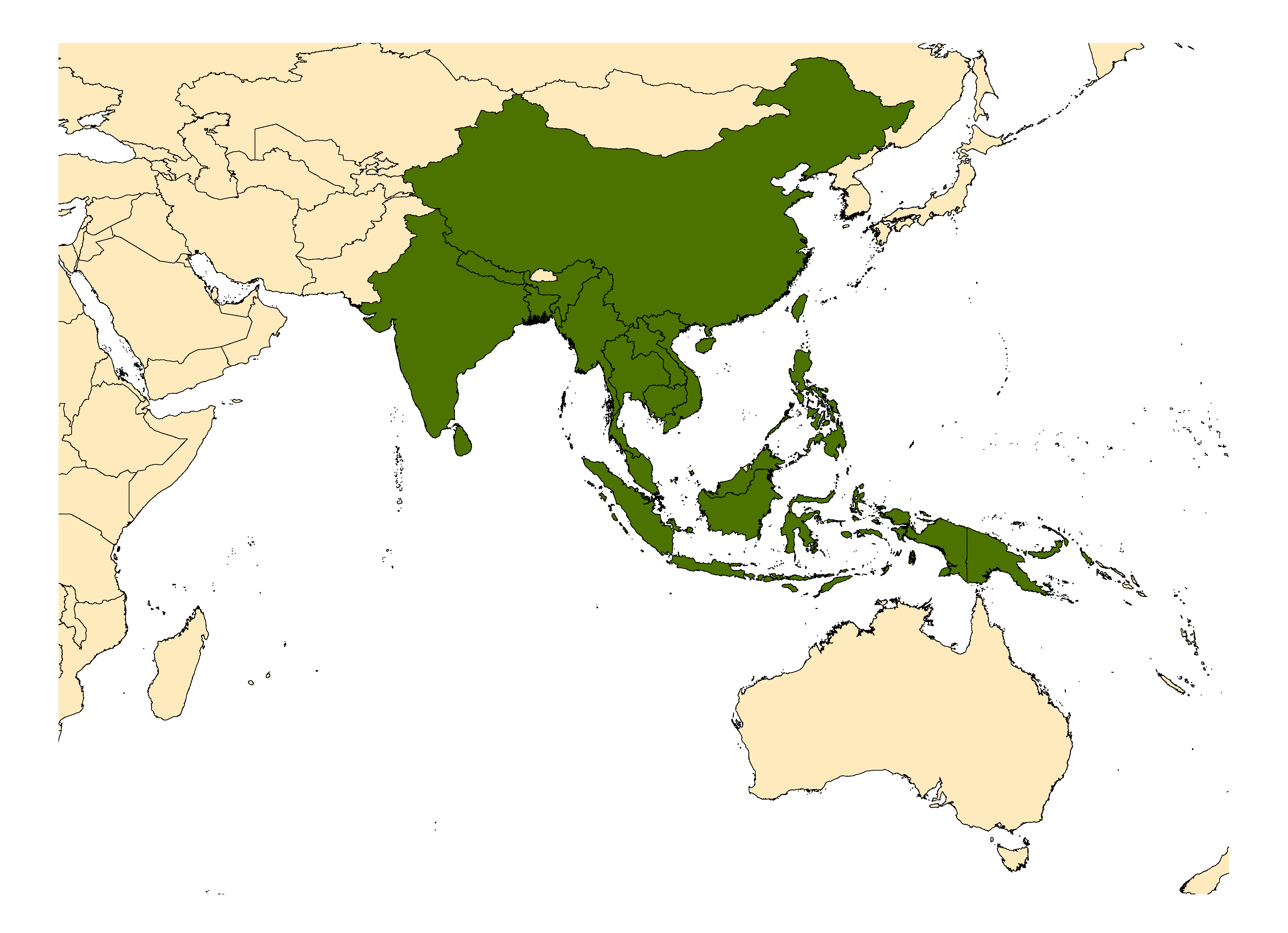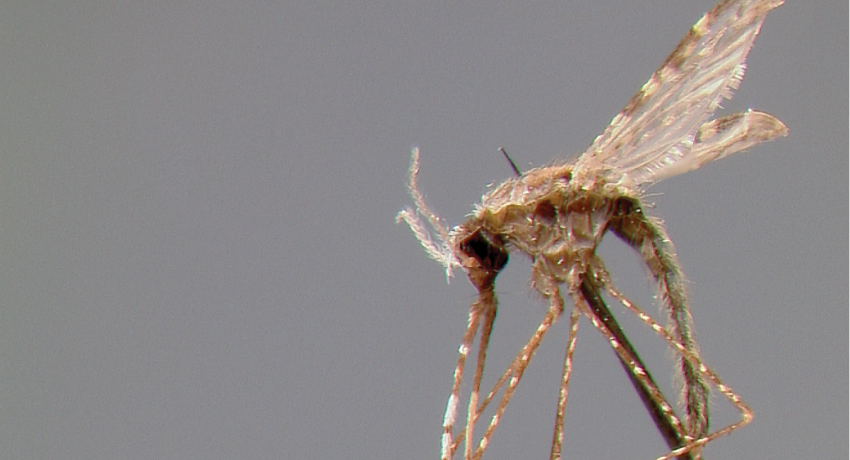AUSTRALASIAN, INDO-ORIENTAL AND PALEARCTIC REGIONS
Etymology: mosaic, checkered (L); refers to thoracic pattern
Anopheles tessellatus, the only representative of the Tessellatus Group, has a distinctly spotty look due to excessive banding on its legs and palps, and the ornate patterning of its wings. Two subspecies are recognized: An. tessellatus kalawara Stoker & Waktoedi and An. tessellatus orientalis (Swellengrebel & Swellengrebel de Graaf). WRBU’s recent DNA barcoding studies showed suggests that Philippine populations comprise a new species in comparison to topotypic populations of An. tessellatus s.s.
Type locality: Taipang [=Taiping], Perak, Malaya [Malaysia]
Type depository: Natural History Museum, London, England, United Kingdom (NHMUK)
DIAGNOSTIC CHARACTERS (Click photos to view; mouse over and click large photo to zoom in.)
ADULT (illustrated): Head: Palpomeres (MPlp3–5) with broad apical pale bands; proboscis with pale yellowish scales on apical half. Thorax: Antepronotal scales present; upper proepisternal setae present; capitellum of haltere white-scaled dorsally. Wing: Pale fringe spots at end of all wing veins. Legs: Fe-I–III and Ti-I–III speckled; abdomen without ventral median tufts of dark scales; apex of Ti-III with a narrow pale band; Ta-III1–4 with small apical pale bands.
LARVA (not illustrated): Head: Seta 1-A small, single. Thorax: Seta 1-P usually 2–5 branched, inserted on lightly pigmented basal tubercle; setae 9,10-P,M,T single. Abdomen: Segments IV-VII with small tergal plates (TP) not enclosing small median accessory tergal plates (ATP); segments IV-VII with tergal plates smaller than distance between bases of each pair of palmate setae; seta 1-I,II much reduced palmate; seta 1-III–VII palmate with apical filaments usually <0.5 as long as basal portion.
TAXONOMIC KEYS
Amerasinghe 1995
Baisas & Dowell 1967
Nguyen Thuong Hien 1968
Rattanarithikul & Harrison 1973
Tanaka et al. 1979
Lee et al. 1987b
Darsie & Pradhan 1990
Rattanarithikul et al. 2006b
Oo et al. 2006
![]()
WRBU – Anopheles – Neomyzomyia Series – Indomalayan Region – Larva
![]()
WRBU – Anopheles – Neomyzomyia Series – Oriental Region – Adult
![]()
WRBU – Anopheles – Neomyzomyia Series – Oriental Region – Larva
![]()
WRBU - Genera - Global - Adult
![]()
WRBU - Genera - Global - Larva
![]()
WRBU - Genera - Indomalaya - Adult
![]()
WRBU - Genera - Indomalaya - Larva
![]()
WRBU - Genera - Oriental - Adult
![]()
WRBU - Genera - Oriental - Larva
![]()
WRBU - Anopheles Subgenera and Series - Indomalaya - Adult
![]()
WRBU - Anopheles Subgenera and Series - Indomalaya - Larva
![]()
WRBU - Anopheles Subgenera and Series - Oriental - Adult
![]()
WRBU - Anopheles Subgenera and Series - Oriental - Larva
Exemplar DNA sequences
An. tessellatus COI: MK685249, MK685260, MF179266-71
BIONOMICS
Immatures
Somewhat unusually for Anopheles mosquitoes, An. tessellatus s.l. females seek out dirty stagnant ground water for oviposition. Habitats are either in open sunlight or in shaded habitats and can include the muddy, organic wallows frequented by water buffalo. In nature, it is rare to find high densities of An. tessellatus s.l. larvae, suggesting that females dart around, placing eggs in multiple locations.
Adults
In the laboratory, Indian populations of An. tessellatus s.l. took 3–4, 7–9, and 1–2 days for the egg, larval and pupal stages, respectively. Females take 5–7 days after emergence to mate, blood feed and lay their first batch of eggs. Although highly competent to transmit human malarias, An. tessellatus s.l. is predominantly zoophilic (preferring cattle), and only becomes locally significant at high populations densities, or where preferred are scarce, e.g., in the Maldives—where it also acts as the vector of Bancroftian filariasis. It is predominantly zoophilic, with up to 20 times more mosquitoes collected on cattle than on humans. Females will enter houses to bite humans and take several blood meals in a single gonotrophic cycle.
DISTRIBUTION NOTES
Bangladesh, Bhutan, Cambodia, Guam, India, Indonesia, Laos, Malaysia, Maldives, Myanmar, Nepal, Papua New Guinea, People's Republic of China, Philippines, Solomon Islands, Sri Lanka, Taiwan, Thailand, Timor, Vietnam.

WRBU VECTOR HAZARD REPORTS
None; View other WRBU Vector Hazard Reports
Available GIS Models
IMPORTANT REFERENCES (full citations below)
Theobald 1901a: 175 (F*)
Christophers & Barraud 1931: 174 (E*)
Christophers 1933: 182 (M*, F*, P, L*, E)
Crawford 1938: 82 (P*)
D'Abrera 1944: 353 (E)
Colless 1948: 98 (M*, F*, L*)
Bonne-Wepster & Swellengrebel 1953: 274 (M*, F*, L*; as tesselatus)
Baisas & Ubaldo-Pagayon 1956: 224 (1st instar L*, E*)
Hara 1959: 112 (F genitalia*)
Amerasinghe 1995 (P*; key, Sri Lanka)
Baisas & Dowell 1967 (F*, L*; keys, Philippines)
Nguyen Thuong Hien 1968 (F*, L*; keys, taxonomy, bionomics, Vietnam)
Reid 1968: 257 (M*, F*, P*, L*, E*)
Miyagi et al. 1969: 33 (taxonomy)
Aslamkhan 1971b (distribution; Pakistan)
Basio 1971b: 46 (M*, F*; bionomics)
Basio & Reisen 1971: 60 (L; distribution)
Rattanarithikul & Harrison 1973 (L*; key, Thailand)
Narang et al. 1974 (chromosomes)
Baisas 1974: 72 (M, F*, P, L*; taxonomy, bionomics, distribution; Philippines)
Tanaka et al. 1975c: 210 (bionomics, distribution)
Tanaka et al. 1979 (M*, F*, P, L*; keys)
Lee et al. 1987b: 301, 306 (sensu lato; F key, taxonomy, bionomics, distribution, review)
Darsie & Pradhan 1990 (F, L; tax., keys, bionomics, distribution; Nepal)
Whelan & Hapgood 2000 (bionomics, distribution; East Timor)
Oo et al. 2004 (distribution; Myanmar)
Rattanarithikul et al. 2006b (F*, L*; bionomics, distribution, keys)
Oo et al. 2006 (F*, L*; keys, Myanmar)
Namgay et al. 2018 (distribution, bionomics; Bhutan)
CURRENT SYNONYMS
syn. formosae Hatori
1901: 275 (A*). Type locality: Taihoku, Kielun & Tansui, Formosa [Taiwan, ROC] (LU).
syn. deceptor Dönitz
1902: 60 (F*). Type locality: Sumatra [Indonesia] (NE).
syn. thorntonii Ludlow
1904a: 69 (F; Myzomyia). Type locality: Cottabato [Cotabato], Mindanao, Philippines (USNM). References: Stone & Knight 1956b: 280 (type information, lectotype designation).
syn. ceylonica Newstead & Carter
1910: 377 (A*; Dactylomyia). Type locality: Trincomalee, Ceylon [Sri Lanka] (NHMUK).
syn. kinoshitai Koidzumi
1917: 135 (F). Type locality: Ryukokosho, Taihoku (Taipei), Formosa [Taiwan, ROC] (LU).
syn. taiwanensis Koidzumi
1917: 135 (F). Type locality: Garden of Central Inst, Formosan Government & Banshoryo, Ako Prefecture, Formosa [Taiwan, ROC] (LU).
ssp. orientalis (Swellengrebel & Swellengrebel de Graaf)
1920 (1919): 3 (L*; Neomysomyia punctulata variety). Type locality: North Celebes [Sulawesi], Moluccas & East Java [Indonesia] (NE). Distribution: Indonesia. References: Bonne-Wepster & Swellengrebel 1953: 279 (F*, L*); Harbach & Howard 2007: 39 (to subspecies). Etymology: n.s. [from the east (L)]. Informal name: Eastern Indonesian Nail Mosquito.
ssp. kalawara Stoker & Waktoedi Koesoemawinangoen
1949: 54 (A*). Type locality: Kalawara, Sulawesi Utara, Indonesia (LU). Distribution: Indonesia. References: Harbach & Howard 2007: 40 (to subspecies). Etymology: named after type locality. Informal name: Kalawara Indonesian Nail Mosquito.
CURRENT SUBSPECIES
None
CITED REFERENCES
Amerasinghe, F.P. (1995). A guide to the identification of the anopheline mosquitoes of Sri Lanka. 3. Pupae. Journal of the National Science Council of Sri Lanka, 23(3), 115–129.
Aslamkhan, M. (1971b). The mosquitoes of Pakistan I. A checklist. Mosquito Systematics, 3(4), 147–159.
Baisas, F. E. (1974). The mosquito fauna of Subic Bay Naval Reservation, Republic of the Philippines. San Francisco: Headquarters, First Medical Service Wing (PACAF), San Francisco.
Baisas, F. E., & Dowell, F. H. (1967). Keys to the adult female and larval anopheline mosquitoes of the Philippines. Journal of Medical Entomology, 4(1), 11–24.
Baisas, F. E., & Ubaldo-Pagayon, A. (1956). Notes on Philippine mosquitoes. XVII. The eggs and first-instar larvae of some Neomyzomyias. Philippine Journal of Science, 85(2), 215–230.
Basio, R. G. (1971b). The mosquito fauna of the Philippines (Diptera, Culicidae). Manila: National Museum of the Philippines. 198pp.
Basio, R. G., & Reisen, W. K. (1971). On some mosquitoes of Guam, Marianas Islands (Diptera: Culicidae). Philippine Entomologist, 2(1), 57–61.
Christophers, S.R. (1933). The fauna of British India, including Ceylon and Burma. Diptera.Vol. IV. Family Culicidae. Tribe Anophelini. London: Taylor and Francis.
Christophers, S.R., & Barraud, P.J. (1931). The eggs of Indian Anopheles, with descriptions of the hitherto undescribed eggs of a number of species. Records of the Malaria Survey of India, 2(1), 161–192.
Colless, D.H. (1948). The anopheline mosquitoes of north-west Borneo. Proceedings of the Linnean Society of New South Wales, 73, 71–119.
Crawford, R. (1938). Some anopheline pupae of Malaya with a note on pupal structure. Singapore: Printed at the Government Printing Office, by W.T. Cherry, Government Printer.
D'Abrera, V.S.E. (1944). The eggs of the Ceylon anopheline mosquitoes. Journal of the Malaria Institute of India, 5(3), 337–359.
Darsie, R.F., Jr., & Pradhan, S.P. (1990). The mosquitoes of Nepal: Their identification, distribution and biology. Mosquito Systematics, 22(2), 69–130.
Dönitz, W. (1902). Beitrage zur Kenntniss der Anopheles. Zeitschrift fur Hygiene, 41, 15–88.
Hara, J. (1959). Taxonomical notes on the female terminalia of some anopheline mosquitoes of Japan and Formosa. Taxonomic and ecological studies on mosquitoes of Japan (Part 12). Japanese Journal of Experimental Medicine, 29, 107–119.
Harbach, R.E., & Howard, T. M. (2007). Corrections in the status and rank of names used to denote varietal forms of mosquitoes (Diptera: Culicidae). Zootaxa, 1542, 35–48.
Harbach, R.E., & Howard, T. M. (2007). Corrections in the status and rank of names used to denote varietal forms of mosquitoes (Diptera: Culicidae). Zootaxa, 1542, 35–48.
Hatori, S. (1901). Species of Anopheles from Formosa. Kwampo (Off Rpts Jpn Gov) (5534), 274–275.
Koidzumi, M. (1917). On the anopheline mosquitoes from Formosa. Dobutsugaku Zasshi, Tokyo, 29, 131–142, 351–355.
Koidzumi, M. (1917). On the anopheline mosquitoes from Formosa. Dobutsugaku Zasshi, Tokyo, 29, 131–142, 351–355.
Lee, D.J., Hicks, M.M., Griffiths, M., Debenham, M.L., Bryan, J.H., Russell, R.C., . . . Marks, E.N. (1987b). The Culicidae of the Australasian region. Volume 5. Commonwealth Department of Health, School of Public Health and Tropical Medicine Monograph Series, 2.
Ludlow, C.S. (1904a). Concerning some Philippine mosquitoes. Canadian Entomologist, 36, 69–72.
Miyagi, I., Lha, S., & Kishimoto, T. (1969). Discovery of Anopheles tessellatus in Ryukyu Islands. Tropical Medicine, Nagasaki, 11, 33–36.
Namgay,R., Drukpa, T., Wangdi, T., Pemo, D., Harbach, R. E., Somboon, P. (2018). A checklist of the Anopheles mosquito species (Diptera: Culicidae) in Bhutan. Acta Tropica 188 (2018) 206–212.
Narang, N., Narang, S., & Kitzmiller, J.B. (1974). The salivary gland chromosomes of Anopheles tessellatus. Cytologia, 39(1), 1–10.
Newstead, R., & Carter, H.F. (1910). Descriptions of a new genus and three new species of anopheline mosquitos. Annals of Tropical Medicine and Parasitology, 4, 377–383.
Oo, T.T., Kaiser, A., & Becker, N. (2006). Illustrated keys to the anopheline mosquitoes of Myanmar. Journal of Vector Ecology, 31(1), 9–16.
Oo, T.T., Storch, V., & Becker, N. (2004). Review of the Anopheles mosquitoes of Myanmar. Journal of Vector Ecology, 29(1), 21–40.
Rattanarithikul, R., & Harrison, B.A. (1973). An illustrated key to the Anopheles larvae of Thailand. U S Army Medical Component, SEATO, Bangkok, Thailand.
Rattanarithikul, R., Harrison, B.A., Harbach, R.E., Panthusiri, P., & Coleman, R.E. (2006b). Illustrated keys to the mosquitoes of Thailand. IV. Anopheles. Southeast Asian Journal of Tropical Medicine and Public Health, 128(Supplement 2), 2.
Reid, J.A. (1968). Anopheline mosquitoes of Malaya and Borneo. Studies from the Institute for Medical Research Malaysia, 31, 1–520.
Stoker, W. J., & Waktoedi Koesoemawinangoen, R. (1949). Illustrated map of the anopheline imagines of Indonesia (English trans.): Ministry of Health, Djakarta.
Stone, A., & Knight, K.L. (1956b). Type specimens of mosquitoes in the United States National Museum. III. The genera Anopheles and Chagasia (Diptera, Culicidae). Journal of the Washington Academy of Sciences, 46(9), 276–280.
Swellengrebel, N.H., & Swellengrebel de Graaf, J.M.H. (1920). Addenda to bescription [sic] of larvae of Netherlands Indian anophelines. Burgerlijken Geneeskundigen Dienst in Nederlandsch-Indie. Mededeeligen., 9(1919)(Add.)), 1–3.
Tanaka, K., Mizusawa, K., & Saugstad, E.S. (1979). A revision of the adult and larval mosquitoes of Japan (including the Ryukyu Archipelago and Ogasawara Islands) and Korea (Diptera: Culicidae). Contributions of the American Entomological Institute, 16, 1–987.
Tanaka, K., Saugstad, E.S., & Mizusawa, K. (1975c). Mosquitoes of the Ryukyu Archipelago (Diptera: Culicidae). Mosquito Systematics, 7(3), 207–233.
Theobald, F.V. (1901a). A monograph of the Culicidae or mosquitoes (Vol. 1). London: British Museum (Natural History). [424pp]
Whelan, P., & Hapgood, G. (2000). A mosquito survey of Dili, East Timor, and implications for disease control. Arbovirus Research in Australia, 8, 405–416.
CITE THIS PAGE
Walter Reed Biosystematics Unit (Year). Anopheles tessellatus species page. Walter Reed Biosystematics Unit Website, http://wrbu.si.edu/vectorspecies/mosquitoes/tessellatus, accessed on [date (e.g. 03 February 2020) when you last viewed the site].










































































































































































